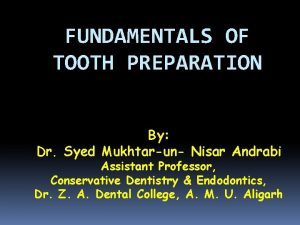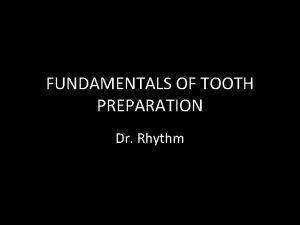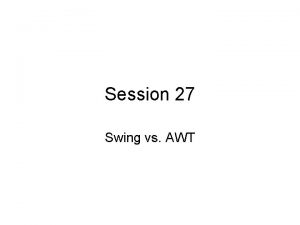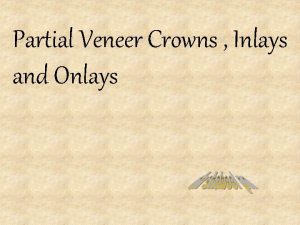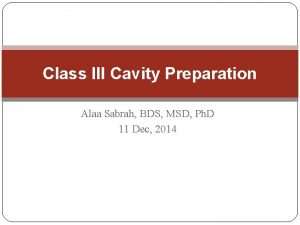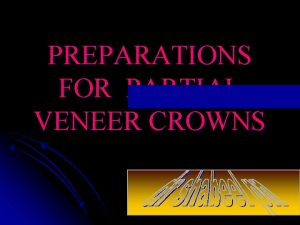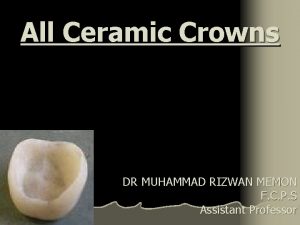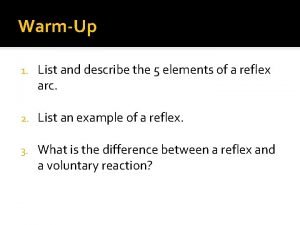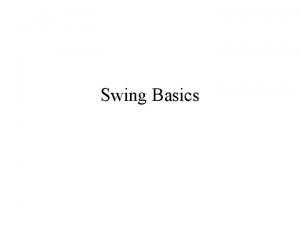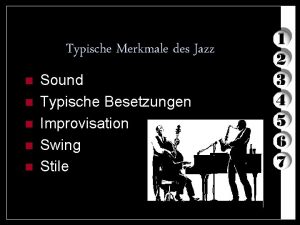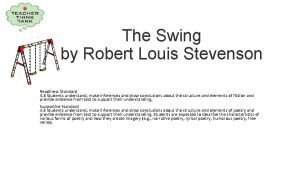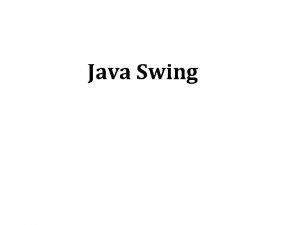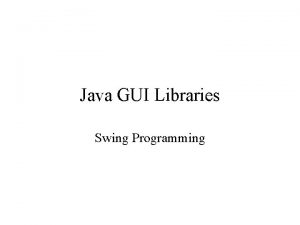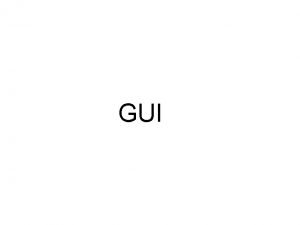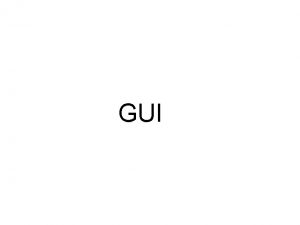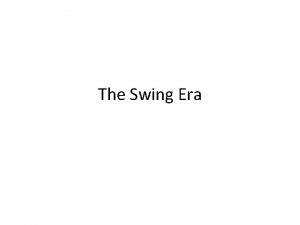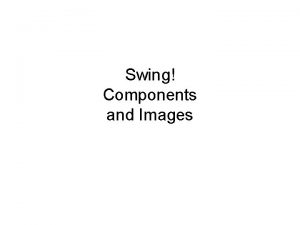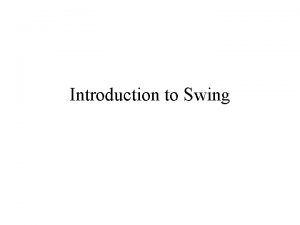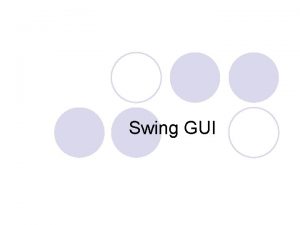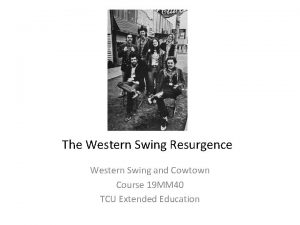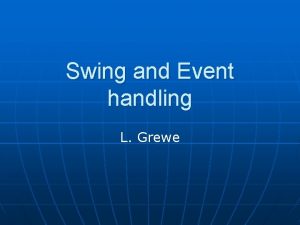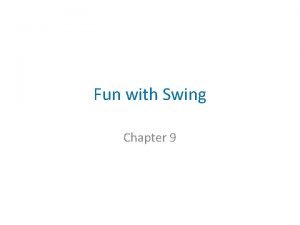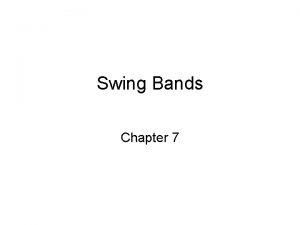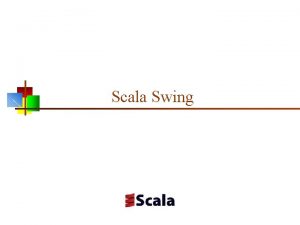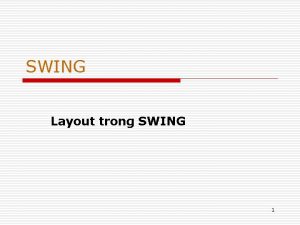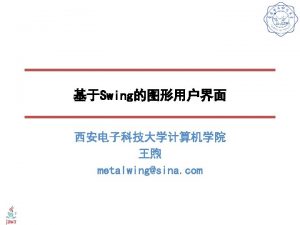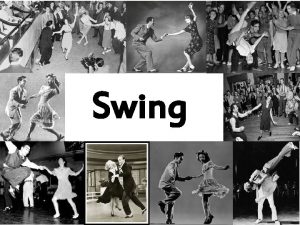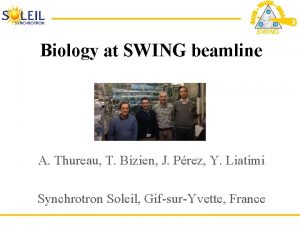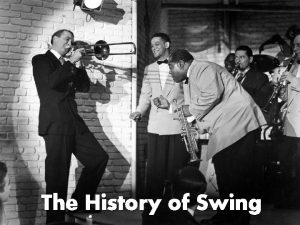Microrhythm and macromovements in performance of swing grooves
























- Slides: 24

Micro-rhythm and macro-movements in performance of swing grooves Carl Haakon Waadeland Department of Music Norwegian University of Science and Technology (NTNU) Trondheim E-mail: carl. haakon. waadeland@hf. ntnu. no 1

Introduction A swing groove in jazz: The performance of this groove might: (a) Identify the individual drummer, - in terms of: Accentuation Subdivision Push/laid back 2

(b) Show discrepancies from the note values in the written representation above (c) At different times be ”swinging” Make the listener want to move along with the rhythm 3

Rehearsing to play swing grooves requires: (a) (b) Excercises in coordinated movements of hands and feet Coordination of drumstick, hand, wrist and elbow Output various movement strategies for relaxed performances of swing grooves 4

A main focus of this investigation: To achieve analytical insight into swing performances by studying the drummers’ movements in the performance Basic question asked: How are movement patterns related to rhythmic phrasing in performance of swing grooves? . . To study this we have constructed a series of experiments: 5

Empirical investigation Subjects: Jazz drummers, students and teachers at Dept. of Music, NTNU – section of jazz education. Aim: Study possible relations between the drummers’ movements and the following performance parameters: n Tempo n Dynamics n Rhythmic subdivision 6

Method/Equipment for Measuremets (Measurements assisted by Geir Oterhals Section of Movement Science, NTNU) Cameras (6) transmitting infra red light ”Force plate” measuring force from drumstick Markers (5) reflecting the light 7

The following equipment is used: n 6 cameras (Proreflex camera system) are used to measure movements of the arm and the drumstick (kinematics). Sampling rate: 240 Hz n A force plate (Kistler) is used to give accurate measurements of attack points and musical dynamics. Sampling rate: 960 Hz n A minidisk is used for audio recording of the experiment 8

Results from a case study Experiment (0): Subject: S 09 Task: Play swing groove on the force plate (120 bpm) b 1 b 2 b 3 b 1´ b 2´ b 3´ 9

Vertical displacement of drumstick/hand/wrist: b 1 b 2 i) Periodic-like movement patterns ii) On b 2 and b 2´ the drumstick strokes precede the minima of hand wrist movements iii) b 1 and b 1´ are performed with the hand wrist moving upwards, preparing strokes on b 2 and b 2´ 10

Looking at 4 measures of drumstick movement: b 1 b 2 b 3 iv) Largest preparatory height (hp) for b 2. In fact: hp(b 1) < hp(b 3) < hp(b 2) (*) Natural explanation: n (*) is reflecting the inter-onset intervals (IOI) n (*) is reflecting the distribution of accents (which is also related to striking velocities, acceleration and force data) (c. f. also S. Dahl) 11

v) For timing analysis we measure the IOIs (over an interval of 4 measures): Let d 1 = IOI(b 1, b 2); i. e. : the duration of the first beat, and let d 2 and d 3 be similarily defined. We find: (d 2 + d 3) > d 1 Average, 4 measures: (d 2 + d 3)/d 1 = l. 03 (in this tempo (124 bpm): d 2 + d 3 = d 1 + 15 ms) 12

vi) Swing ratio (SR) is defined as: SR = (d 2/d 3) (cf. Friberg & Sundström) Observe: SR = 1: SR = 2: SR = 3: Eighth note subdivision Eighth note triplet subdivision Sixteenth note subdivision Calculating SR for every pair of (d 2, d 3) intervals, and averaging over the 8 pairs, we get: SR(average exp(0)) = 2. 1 i. e. a triplet-close subdivision in the performance, slightly to the sixteenth note side 13

Next series of experiments: Impose additional playing conditions: With count-in tempo 120 bpm, play swing groove on the force plate with accent on 1) every first 2) every second 3) every third beat (resp. ) in the swing cycle Question: How do these additional conditions affect the performance compared to the (neutral) situation in Experiment (0) ? 14

We exemplify by: Experiment (3): > b 1 b 2 > b 3 Look at vertical displacement of drumstick, hand wrist: 15

Exp (3): b 1 b 2 b 3 Exp (0): 16

Compared to Exp(0) we find: i) Totally different periodic-like movement patterns ii) On b 2 the hand wrist have started an upward movement, preparing the accented stroke on b 3 iii) Minor vertical movement of hand wrist on b 1 iv) Looking at drumstick movement: Largest preparatory height for b 3 whereas hp(b 1) and hp(b 2) are about the same This reflects the distribution of accents, but does not reflect the IOIs (as was the case in Exp(0)) 17

Measuring IOIs and comparing to Exp(0) we find: v) In the performance of Exp(3) the interval starting with the accent is lengthend (cf. also S. Dahl) vi) The lengthening takes duration from both intervals 1 and 2 vii) The inequality (d 2 + d 3) > d 1 is enlarged (In Exp(3): Average (d 2 + d 3)/d 1 = 1. 08 (as compared to 1. 03)) 18

viii) Calculating swing ratios and averaging over 8 measures, we get: SR(average exp(3)) = 1. 8 (compared to 2. 1) i. e. still a triplet-close subdivision in the performance, but now slightly to the eighth note side (This is also indicated in the previous figure) 19

Conclusions for this case study The additional playing conditions imposed in Exp(3) have: n Major effect on movement strategies in the performance n Noticable effect on timing, especially on: - The duration of the accented note - The swing ratio - Strengthening an occurence of shorter-longer durations of the 1 -2 -3 -4 in the swing 4/4 -measure Next step: n A comparison between several subjects n Develop new tools for classification of movements 20

Further analysis of movements A method of analysis which gives additional information of movement patterns and appears useful as a tool for distinguishing between movement categories, is spectral analysis By this method the sinusoidal components of the movement patterns are detected The analysis is done by using Matlab calculating FFT (Fast Fourier Transform) 21

Example: FFT of Exp(0) f 1 f 2 f 3 f 4 Observe: i) FFT gives sinusoidal components with frequencies f 1, f 2, f 3, …. ii) Harmonic spectrum, reflecting periodic movement curve iii) The frequencies represent note values: f 2=2. 067 Hz, i. e. 124 bpm, which corresponds to quarter note f 1: half note, f 4: eighth note, etc. 22

FFT of Exp(3): Compared to FFT of Exp(0): iv) Same spectral components, but noticable differences in relative amplitudes (reflect the distribution of preparatory heights) 23

Conclusion for FFT analysis of swing (so far) n n n FFT represent differences in movement patterns by differences in relative strength of sinusoidal components corresponding to note values in the performance The detection of sinusoidal components might be used to make models that simulate the movements of the performance FFT detects mean tempo, but does not convey (local) timing information (in order to do that it is more appropriate to apply short time FFT or wavelet analysis) 24
 Locks in cavity preparation
Locks in cavity preparation Pharyngeal grooves and pouches
Pharyngeal grooves and pouches Features of primary retention form
Features of primary retention form Java awt vs swing
Java awt vs swing Isthmus tooth preparation
Isthmus tooth preparation Partial veneer crown indications
Partial veneer crown indications Convoluted ridge between anatomical grooves
Convoluted ridge between anatomical grooves Bullet anatomy
Bullet anatomy Class 3 cavity
Class 3 cavity Porcelain jacket crown indications
Porcelain jacket crown indications Posterior three quarter crown
Posterior three quarter crown Orientation grooves
Orientation grooves Brain grooves
Brain grooves Spinal cord anatomy
Spinal cord anatomy Performance management vs performance appraisal
Performance management vs performance appraisal Behaviorally anchored rating scales
Behaviorally anchored rating scales 2018 jcids manual
2018 jcids manual Jimmy and eric were huddled by the tire swing
Jimmy and eric were huddled by the tire swing Difference between swing and applet
Difference between swing and applet Components of swing
Components of swing Merkmale des jazz
Merkmale des jazz Softball ontario rules
Softball ontario rules Till i can see so wide
Till i can see so wide Swing check valve symbol
Swing check valve symbol How the customer explained it
How the customer explained it
